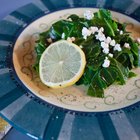
The major citrus fruits all have distinctively fresh and aromatic flavors, well suited for a variety of kitchen uses. Lemons, arguably the most versatile, work well in cooking, baking, sauces and most other culinary creations. Some recipes call for lemon juice, which provides a lemony flavor and a refreshingly deep acidic tang. Others call for the peel, or more accurately the zest, which provides a stronger lemon flavor with less acidity.
Peel vs. Zest
The lemon's peel consists of two distinct layers. The colorful outer layer, or zest, contains the flavor while the soft inner portion, or pith, is mostly bitter. The whole peel is sometimes candied for baking, but in cooking you'll invariably use just the zest. You can shred it using the fine side of a box grater or a modern plane-style grater, with its tiny flat blades. Chefs use a tool with tiny loops that removes the zest in thin, attractive strands. You can do the same by removing the zest in strips with a vegetable peeler, then cutting it by hand with a sharp knife.
Cooking with Lemon Zest
Lemon zest can be added directly to sauces near the end of their cooking time, to add a fresh, bright note to the flavor. You can also sprinkle finely grated or minced zest on fish or chicken, before it's grilled or baked. The lemon flavor will infuse into the portions while cooking. Lemon zest can also be used as a garnish, either by itself or in preparations such as the Italian "gremolata," where it's mixed with parsley and garlic and used on rich braised dishes such as osso buco.
Preserved Lemon Zest
Although zest is a versatile ingredient when fresh, preserved zest can be even more useful. Most obviously, it's a long-storage substitution for times when fresh lemons might not be available. Dried zest provides concentrated flavor to sauces, stir-fries and baked dishes in the same ways you'd use fresh zest. However, you can also grind dried zest in your spice grinder and use it to add a fresh, tart flavor to spice rubs and marinades. You can incorporate powdered zest into breading mixtures, adding its distinctive flavor to crisp fish or shrimp. Candied zest works well in sauces and glazes, where its sweetness is an asset.
Blanching and Preserving
You might occasionally notice that fresh lemon zest adds a bitter flavor to your cooking, while dried zest doesn't. That's because dried zest is blanched, a step that mutes its flavor slightly but largely eliminates the bitterness. To blanch your own, place fresh zest in a a heatproof dish or measuring cup and cover it with boiling water. After 2 minutes, drain the zest and pat it carefully dry on paper towels. The volatile compounds causing that bitterness will drain away, leaving a milder zest. You can compensate for the slight loss of flavor by using more zest in your recipe.
Related Articles
Substitutes for Lemon or Orange Peel
Can You Eat Ginger Peel?

How to Make Lemonade Using Meyer Lemons

Galangal Powder Substitute

About Fresh Ginger Substitutes

Facts on Zest Bar Soap

Difference Between Peppermint Extract & ...

Baking Substitution for Rosewater
A Substitute for Grated Lemon Peel

How to Eat Fennel Raw
Homemade Pico de Gallo Recipe

What Is a Good Substitute for Cherries?

Substitutes for the Saffron Spice

What Can I Substitute for the Flavor of ...

How to Cook Chard

How to Eat a Quince
How Long Does Watermelon Stay Fresh ...

What Is Mixed Peel?

Can You Eat Clementines With the Peel?

How to Store Shallots
References
- On Food and Cooking: The Science and Lore of the Kitchen; Harold McGee
- The Cook's Thesaurus: Citrus Fruit
- The Spice House: Lemon Peel Zest
Writer Bio
Fred Decker is a trained chef and certified food-safety trainer. Decker wrote for the Saint John, New Brunswick Telegraph-Journal, and has been published in Canada's Hospitality and Foodservice magazine. He's held positions selling computers, insurance and mutual funds, and was educated at Memorial University of Newfoundland and the Northern Alberta Institute of Technology.
Photo Credits
Hemera Technologies/AbleStock.com/Getty Images